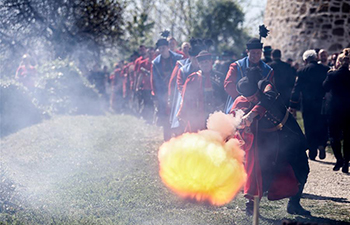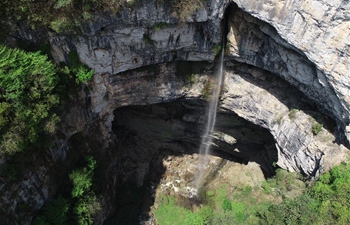DAMASCUS, April 23 (Xinhua) -- A 3D-printed ceiling of a worship area of the Bel Temple of Palmyra was showcased in the Damascus National Museum on Tuesday.
Italian artists replicated the part of the ceiling that was produced as a gift to the national museum.
The original part of the ceiling was destroyed along with the entire Bel Temple by the Islamic State (IS) group during its invasion of the ancient oasis city of Palmyra in 2014.
It is worth mentioning that the replica is more than 4 meters long and about 1.5 meters wide. Its thickness is 80 cm and weighs 190 kg.
It was displayed at the Colosseum and at the United Nations Building in Rome. It was also exhibited at the European Parliament in Brussels and UNESCO headquarters in Paris and was recently presented to the Directorate General of Antiquities and Museums in Syria.
Frances Pinnock, an Italian archeologist supervising the replication of the ceiling, told Xinhua at the national museum that the idea of producing this piece is to challenge the destruction by the IS.
"In the beginning, it was an emotional answer... you destroy, we rebuild. Then it became a scientific challenge. We didn't want to remake the ceiling when it was built in the second century B.C., but we wanted to reproduce it as it was before the destruction by Daesh (IS)," Pinnock said.
For his part, Khalil al-Hariri, head of the Palmyra Museum, told Xinhua that the replica is 80-percent precise.
He said that such a technique of 3D printing could help the reconstruction of the destroyed sites, as it can serve as a 3D model for the builders rather than just an image.
The Temple of Bel was an ancient temple located in Palmyra, Syria. The temple, consecrated to the Mesopotamian God Bel, who was worshipped at Palmyra in a triad with the lunar god Aglibol and the solar god Yarhibol, formed the center of religious life in Palmyra and was dedicated in 32 A.D.
















